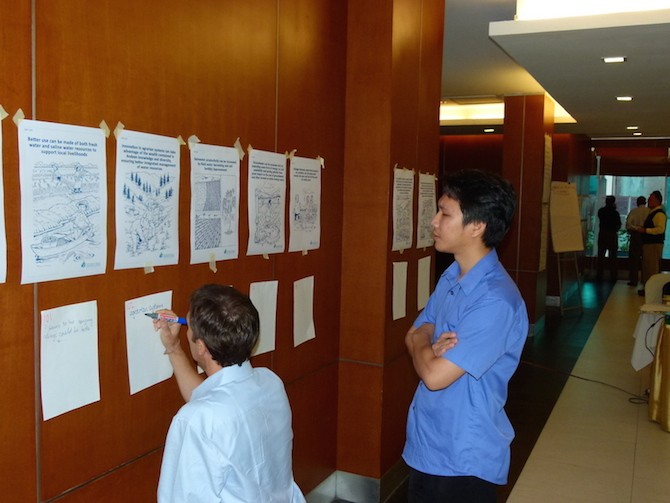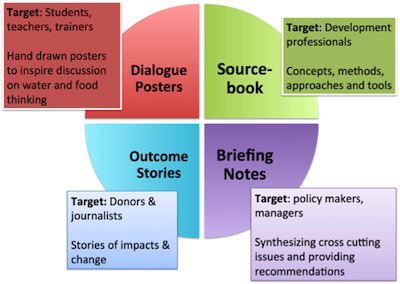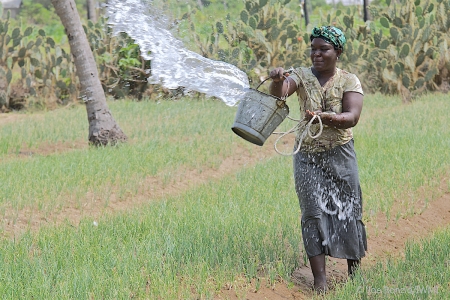The CGIAR Research Programs are essentially centered around the generation and utilization of knowledge. Thus, as much effort needs to be placed on ways to ensure that technical solutions can be used appropriately. Knowledge utilization efforts can take many forms. From engagement platforms that match research knowledge with other perspectives to spur innovation. Or information portals such as the Big Climate Facts, which bring together climate information in an engaging way. To projects which bring to bear a range of model and data systems to improve decision-analysis.
 Participants provide feedback on a dialogue poster during the repackaging review workshop with key stakeholders from CPWF basins. Photo: CPWF
Participants provide feedback on a dialogue poster during the repackaging review workshop with key stakeholders from CPWF basins. Photo: CPWFCGIAR has a relatively long history of pursuing innovative, global, and geographically focused multi-institutional and multi-sectoral research on the issues of water, food, and poverty. The first phase (2004-2008) of the CGIAR Challenge Program on Water and Food (CPWF) consisted of 68 individual research projects spread across 10 river basins in the world; these projects generated an extremely rich range of research findings.
Unfortunately, many lessons and experiences remain locked away in long technical and scientific reports that development managers and decision makers might find difficult to access and learn from. In essence, the challenge for CPWF was to make its treasure trove of knowledge more accessible to different audiences. IFAD provided CPWF with a grant on “mainstreaming innovations” to explore how CPWF research results and knowledge could be better used by IFAD projects and country programs.
Based on this we looked at ways to disseminate and use CPWF’s outputs at a wider scale. We were not looking for a promotional campaign to show the impressive work of CPWF, but rather for ways to make CPWF research results more accessible and to support efforts to make research results more relevant in the then-emerging CPWF Basin Development Challenge programs.
 After much consultation, we settled on the use of a major repackaging exercise that had multiple products, each designed for different purposes and audiences (see diagram). The materials build upon one another in a complementary manner.
After much consultation, we settled on the use of a major repackaging exercise that had multiple products, each designed for different purposes and audiences (see diagram). The materials build upon one another in a complementary manner.
A series of briefing notes were supposed to be the “why” of the series. They were intended to highlight core messages and to be linked to the dialogue posters (unfortunately only draft briefing notes have been completed; they proved more difficult to write than expected due to the effort needed to consolidate multiple sources of information). The outcome stories are the “what” and map both the intended and unintended changes in project impact pathways. The sourcebook is the “how to” and focuses on the tools, approaches, and methods that have been tested and are replicable.
Sourcebook
The process for producing the sourcebook was time intensive and spanned more than two years. The repackaging approach was used mainly because there was an accumulated (and rich) collection of research outputs (reports, research papers, and more). After consulting researchers, a team of editors and illustrators worked with the CPWF team to develop highly simplified and summarized versions of the more detailed CPWF research papers.
Most, though not all, of the project researchers approved of the repackaged versions of their original materials, and many offered suggestions for revisions. Some researchers felt that illustrations and cartoons diminished the ‘seriousness’ of their research and had to be convinced of the value of repackaging research results, as they still perceived it to be a ‘research product’. However, the approach was to grasp the interest of readers via the sourcebook and provide them with access to the original and more detailed papers.
Dialogue Posters
Sifting through the hundreds of CPWF research reports, the team was also able to derive over fifty key messages. The messages were than placed on a large poster with an illustration to visually show it. The purpose of the ‘dialogue’ posters was to provide educators and students with messages and illustrations that could be discussed. The final list of key messages were reviewed by CPWF scientists.
Outcome Stories
Finally, the outcome stories were produced for donors, journalists and as evidence to demonstrate the effectiveness of the CPWF approach. These stories were the most difficult to produce, as they were all prepared from research reports and without the opportunity to visit the sites or cases to do a first-hand assessment. Still, we were able to write these up in creative ways while maintaining scientific rigor. The outcomes stories were a very popular way of showing the types of small changes and outcomes that CPWF was aiming for that resulted in changed attitudes and knowledge, rather than lists of outputs and adoption rates by farmers.
Briefing Papers
The briefing papers would have been a valuable addition by providing a cross-basin synthesis and demonstrating CPWF’s contribution to global science related issues to policy makers. However, we needed to prioritize due to time and resource constraints and therefore focused on the sourcebook, outcome stories and dialogue posters.
Lessons for the future
Reflecting on the experience, and other sourcebook processes, a couple of lessons come to mind for consideration during potential future exercises:
- Time and resources: The repackaging process always takes longer than one might expect and requires quite a few resources. Given how much is invested in knowledge generation, the investment in knowledge utilization also needs to be considered.
- Materials for target audience: There is a need to look for new products and ways to repackage sourcebooks. Many sourcebooks use cartoons and illustrations. More analysis and a clearer definition of sourcebook users would be helpful for finding the appropriate formats. A recent writeshop/repackaging exercise produced materials in an alternative format, namely practice briefs on innovation platforms.
- Networks: The network and coalition built is just as important at the product. In this exercise we built a coalition to help disseminate the sourcebook; however, final production took so long (almost 18 months after bringing the group together) that the network had lapsed a bit by the time dissemination could take place.
That said, from initial reactions and anecdotal evidence, materials are being used in many different ways. The sourcebook has good feedback from development partners and one large agriculture development agency requested more than 25 extra copies for its offices. In addition, universities and research institutes have requested multiple copies. The outcome stories have proved popular with donors and researchers to show the types of outcomes they have produced.
Towards mid-2014, we will evaluate some of these products and hope to have a good evidence base to plan future exercises.
The products described here were developed through support from IFAD. Learn more here: https://waterandfood.org/mainstreaming-innovations/.







/index.jpg?itok=EzuBHOXY&c=feafd7f5ab7d60c363652d23929d0aee)








